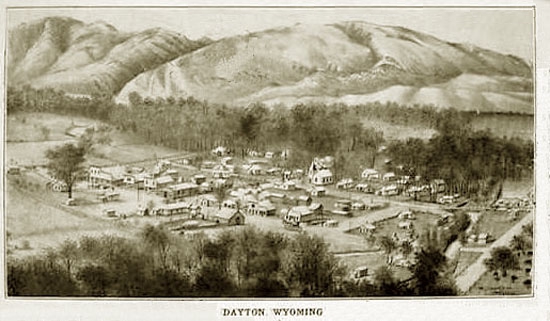
Dayton, 1905
To the north of Sheridan lie the small towns of Dayton and Ranchester. In 1878, with the end of the end of the Indian
Wars, settlers began to establish small ranches and homesteads along the Tongue River. Among the early settlers
was Benjamin F. Smith and his wife and five children. Settlement became easier when in 1879, Col. Mathewson T. Patrick (1834-1899) and his brother, Algernon S. Patrick
(1842-1916), each from Omaha, established a stage line from Rock Creek on the Union Pacific up to Fort Custer,
Montana. The stage line's stations received no better reviews that did the earlier Overland Stage. An 1881 traveller on the line, George Rex Buckman (1854-1915),
secretary of the Powder River Stock Company, wrote of his
36 hour non-stop trip from Rock River to Powder River Country:
Darkness descends, and the stage rumbles on. The night grows cold; we pin down the canvas curtains that serve as doors, brace ourslves each in a corner, and
proceed to pass the night as comfortably as we may. The stage rumbles on through a desolate country over an endless succession of "divides," and
across innumerable gulches, down into which we are precipitated, only the next
instant to be projected against the opposite almost vertical
bank. How much we slept may be imagined; and when the dawn once more brightens the eastern sky, and
the curtains are again rolled up, the same billowy, dreary, water-scarred plain is seen to stretch away in
every direction. Through this country the stage company had difficulty in finding
drinkable water at intervals of about twenty miles upon which to locate stations.
At many places the water is alkaline, brackish, and otherwise mineralized to a degree that
renders it exceedingly repulsive. The stage rumbles on. Soon the snow-covered peaks of the Big Horn Mountains are seen on the
northwestern horizon; later, the handsome Pumpkin-Seed Buttes rise gracefully out of the
rolling plain; away to the west we descry a green line winding across the plain like
a gigantic serpent, which however, we know to be the timber upon the Powder River. Lippincott's Magazine;
"Ranches and Rancheros of the Far West," May 1882.
The Pumpkin-Seed Buttes, now known as Pumpkin Buttes, lie in southwestern Campbell County. The stage would have, indeed,
been passing through a lonely country even today devoid of modern highway. The stage would have passed over a series of
dry creeks and draws including such romantically named landmarks such as "Dead Dog Draw," "Bullwhacker Creek," and the Dry
Fork of Powder River."
Nor was the food on the Patrick Brothers Line any better than that of Ben Holladay:
[T]he bill of fare was to be a dreary constant. Breakfast, dinner, or supper,-- it mattered
not, -- the identical quartette invariably appeared, -- vis, fried bacon, soda or baking powder
biscuit, dried apples, and a decoction of various materials dignified by the name of cofee.
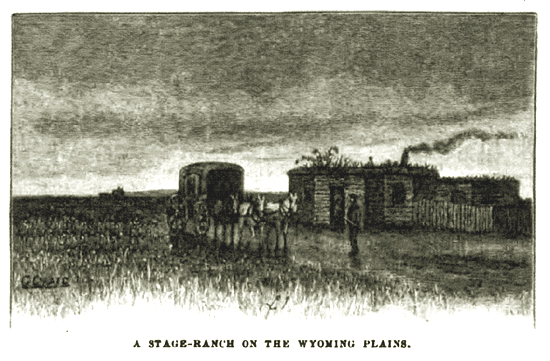
Stage Station on the Patrick Stage Line, 1881
A stage station known as Bingham was located at the Smith homestead on the Tongue River about 2 1/2 miles
east of present day Dayton. The station was apparently a home station since it housed a post office and was the
residence of one stage driver, Jno. Ingraham. John T. Bingham, after whom the station was named, was the superintendent for the northern division of the
stage line. Col. Patrick was well placed politically. For three years during the
Grant administration, Mathewson was the
United States Marshal for Utah Territory and charged with enforcement of the anti-polygamy laws. Indeed, he
personally arrested Brigham Young on a charge of "lascivious cohabitation." Young was placed under house
arrest. Thus, Young was able to continue to reside with his numerous wives pending the outcome of the crimnal
proceedings.
Col. Patrict was able to parlay a lucrative 1877 six-month mail contract for the
Sidney to Deadwood run into an ownership interest in the Gilmer and Salisbury stage lines (the "Deadwood Stage"), establishment in 1878 of the
Laramie City to North Park, Colorado line, transportation contracts with silver mines in Utah, as well as the ownership of the
Rock Creek - Fort Custer line.
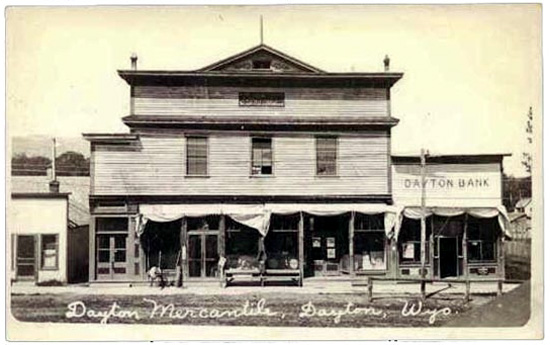
Dayton Mercantile, approx. 1910
As indicated in the next photo, the mercantile building is still in existence. The hitching posts, the bank and the small building
to the left of the mercantile are gone. The most recent use as of this writing (July 2005) was as a
restuarant and dance hall. They are, however, now closed and the building is boarded up and
for sale.
By 1880, the area had obtained a population of sixteen, including the seven members of the Smith family.
Dayton received it name at
a meeting in Henry Baker's general store in 1882. The group selected the middle
name of 21-year old Joseph Dayton Thorn (1861-1942) who with his mother and siblings had
moved to the area from Estes Park, Colo. The following year the little town received a
Post Office. In 1906, a year after the above picture the town was incorporated as
a municipality with Cornelius H. "Neal" Ketcham elected as the first mayor. His successor was Susan
Wissler who served from 1912 to 1915 and holds the distinction of being the
first woman mayor in the United States.
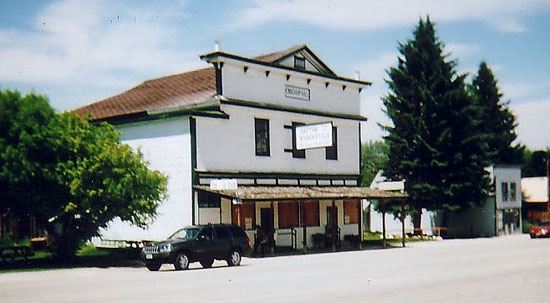
Dayton Mercantile, June 2005. Photo by
Geoff Dobson.
Mrs. Wissler's house at 406 Main St., constructed in 1885, is now
on the National Register of Historic Places. The Wissler house and shop is the small two-story building
on the right in the above photo.
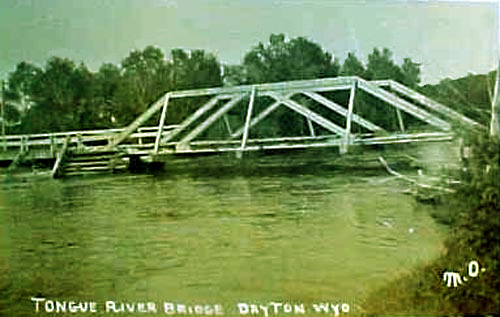
Dayton Bridge, approx. 1915
With the construction of a bridge across the Tongue River at Dayton, the stage line moved its route from
Bingham to Dayton. The site of the old stage station is now an empty field.
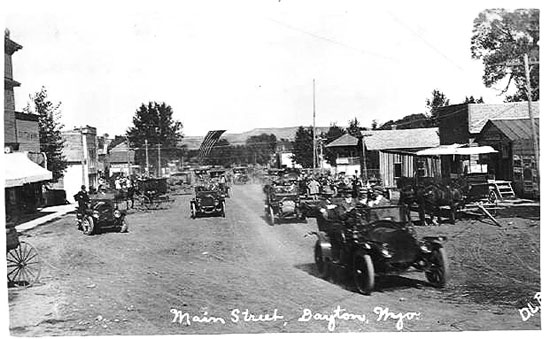
Dayton, 1915
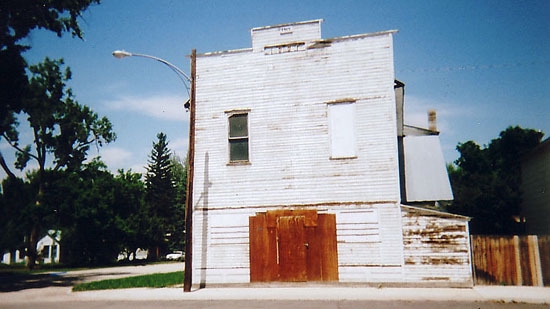
Dayton - Ranchester Odd Fellows Hall, 2005. Photo by
Geoff Dobson
Next Page: Dayton and Ranchester continued, the Tie Industry.
|